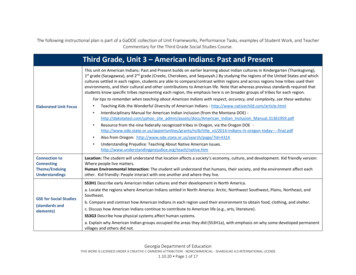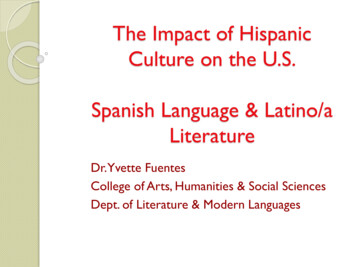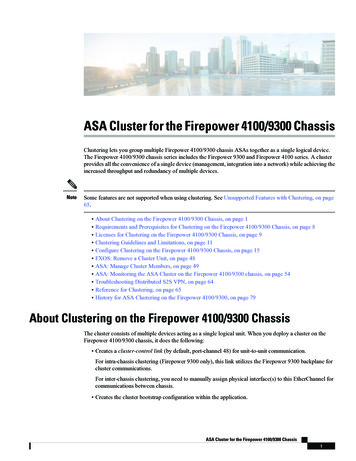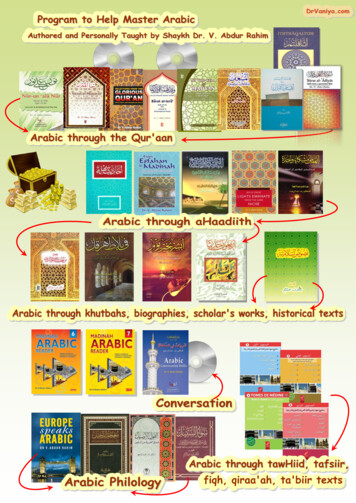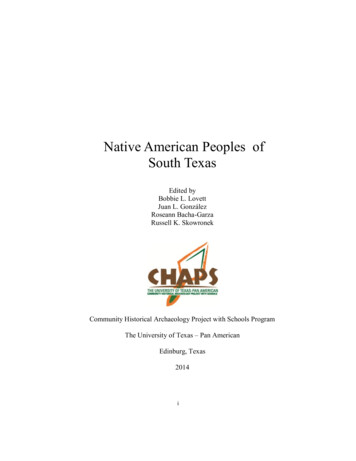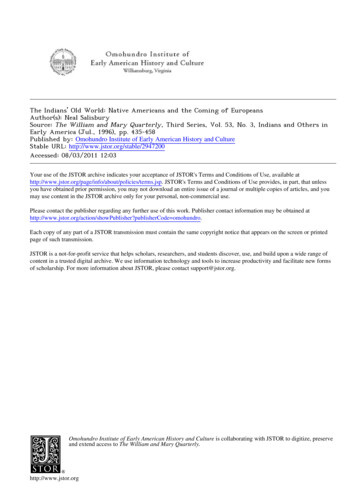
Transcription
The Indians' Old World: Native Americans and the Coming of EuropeansAuthor(s): Neal SalisburySource: The William and Mary Quarterly, Third Series, Vol. 53, No. 3, Indians and Others inEarly America (Jul., 1996), pp. 435-458Published by: Omohundro Institute of Early American History and CultureStable URL: http://www.jstor.org/stable/2947200 .Accessed: 08/03/2011 12:03Your use of the JSTOR archive indicates your acceptance of JSTOR's Terms and Conditions of Use, available at ms.jsp. JSTOR's Terms and Conditions of Use provides, in part, that unlessyou have obtained prior permission, you may not download an entire issue of a journal or multiple copies of articles, and youmay use content in the JSTOR archive only for your personal, non-commercial use.Please contact the publisher regarding any further use of this work. Publisher contact information may be obtained at erCode omohundro. .Each copy of any part of a JSTOR transmission must contain the same copyright notice that appears on the screen or printedpage of such transmission.JSTOR is a not-for-profit service that helps scholars, researchers, and students discover, use, and build upon a wide range ofcontent in a trusted digital archive. We use information technology and tools to increase productivity and facilitate new formsof scholarship. For more information about JSTOR, please contact support@jstor.org.Omohundro Institute of Early American History and Culture is collaborating with JSTOR to digitize, preserveand extend access to The William and Mary Quarterly.http://www.jstor.org
The Indians' Old World: NativeAmericansand the Coming of EuropeansNeal SalisburyCHOLARS in history, anthropology, archaeology,and other disciplineshave turned increasingly over the past two decades to the study ofnative peoples during the colonial period of North American history.The new work in Indian history has altered the way we think about thebeginning of American history and about the era of European colonization.Historians now recognize that Europeansarrived,not in a virgin land, but inone that was teeming with several million people. Beyond filling in some ofthe vast blanks left by previous generations' overlooking of Indians, much ofthis scholarship makes clear that Indians are integral to the history of colonial North America.1 In short, surveys of recent textbooks and of scholarlytitles suggest that Native Americans are well on their way to being "mainstreamed"by colonial historians.Substantive as this reorientation is, it remains limited.2 Beyond the problems inherent in representing Indian/non-Indian interactions during thecolonial era lies the challenge of contextualizing the era itself. Despite opening chapters and lectures that survey the continent's native peoples and cultures, most historians continue to representAmerican history as having beenset in motion by the arrival of European explorers and colonizers.3 Theyhave yet to recognize the existence of a North American-as opposed toNeal Salisburyis Professorof History at Smith College. He wishes to acknowledge the valuable suggestions of seminar participants at the Charles Warren Center for Studies in AmericanHistory, Harvard University, and the National Humanities Center, where he held fellowships,and at the Boston Area Early American History Seminar, the Institute of Early AmericanHistory and Culture, the Five College Social History Seminar, and the Philadelphia Center forEarly American Studies. He also thanks Elizabeth Carney, Ann Lattinville, and Paula Wagonerfor researchassistance;Dena Dincauze, David Hally, and Robert Hasenstab for helpful advice;Kate Blackmerfor providing the maps; and Steven Hackel, Charles Hudson, James Merrell, andDaniel Richter for constructive comments on the manuscript. The title is offered as a compliment to James Merrell.1 See James Axtell, "A North American Perspectivefor Colonial History," History Teacher,I2(I978-i979),549-62. The beginning of this shift was signaled by Gary B. Nash, Red, White,andBlack (Englewood Cliffs, N. J., I973), and Francis Jennings, The Invasion of America:Indians,Colonialism,and the Cant of Conquest(Chapel Hill, I975).2 See James H. Merrell, "Some Thoughts on Colonial Historians and American Indians,"Williamand Mary Quarterly,3d Ser., 46 (i989), io8-io, and Daniel K. Richter, "Whose IndianHistory?" ibid., 50 (I993), 38i-82.3 See FrederickE. Hoxie, The Indians Versusthe Textbooks:Is ThereAny Way Out? (Chicago,1984); Hoxie, "The Problemsof Indian History,"SocialScienceJournal,25 (i988), 389-99.The Williamand Mary Quarterly,3d Series, Vol. LIII, No. 3, July i996
436WILLIAM AND MARY QUARTERLYEnglish or European-background for colonial history, much less to consider the implications of such a backgroundfor understandingthe three centuries following Columbus's landfall. Yet a growing body of scholarship byarchaeologists, linguists, and students of Native American expressive traditions recognizes I492 not as a beginning but as a single moment in a longhistory utterly detached from that of Europe.4 These findings call intoquestion historians' synchronic maps and verbal descriptions of precontactIndians-their cultures, their communities, their ethnic and political designations and affiliations, and their relations with one another. Do thesereally describe enduring entities or do they representepiphenomena of arbitrary moments in time? If the latter should prove to be the case, how willreadingsof Indian history in the colonial period be affected?Far from being definitive, this article is intended as a stimulus to debateon these questions. It begins by drawing on recent work in archaeology,where most of the relevant scholarship has originated, to suggest one way ofthinking about pre-Columbian North America in historical terms.5 Theessay then looks at developments in several areas of the continent duringthe centuries preceding the arrival of Europeans and in the early phases ofthe colonial period. The purpose is to show how certain patterns andprocesses originating before the beginnings of contact continued to shapethe continent's history thereafterand how an understanding of the colonial4 A volume that draws on all these approaches is Alvin M. Josephy, Jr., ed., America inThe Worldof the Indian PeoplesBeforetheArrival of Columbus(New York, I992). The bestsurveys of North American archaeology are Brian M. Fagan, Ancient North America: TheArchaeologyof a Continent(New York, i99i), and Stuart J. Fiedel, Prehistoryof the Americas,2ded. (Cambridge, 1992). On languages see Harold E. Driver, Indians of North America, 2d ed.(Chicago, i969), and Joseph H. Greenberg, Languagein the Americas(Stanford, Calif., I987),esp. chap. 2. Two especially interesting examples of work that utilizes oral traditions as historical sources to supplement "prehistoric"archaeology are Roger C. Echo-Hawk, "Kara KatitPakutu: Exploring the Origins of Native America in Anthropology and Oral Traditions" (M.A. thesis, University of Colorado, I994), and Donald Bahr et al., TheShort,Swift Time of Godson Earth: TheHohokamChronicles(Berkeley, Calif., I994).5 On archaeology as a foundation for Indian history see Bruce G. Trigger, "Archaeologyand the Image of the American Indian," American Antiquity, 45 (i980),662-76, and"American Archaeology as Native History: A Review Essay," WMQ, 3d Ser., 40 (i983),413-52. Among works that incorporate archaeology into historical narratives, the most exemplary by anthropologists are Trigger, The ChildrenofAataentsic:A Historyof the Huron Peopleto i66o (Montreal, I976), and Kathleen J. Bragdon, Native People of SouthernNew England,(Norman, Okla., i996), and by historians, Daniel K. Richter, The Ordeal of theI500-I650Longhouse:The People of the IroquoisLeaguein the Era of EuropeanColonization (Chapel Hill,I992). The most thorough argument for the role of indigenous contexts in shaping postColumbian American history is Francis Jennings, The Foundersof America:How the IndiansDiscoveredthe Land, Pioneeredin It, and CreatedGreat ClassicalCivilizations;How They WerePlunged into a Dark Age by Invasion and Conquest;and How TheyAre Reviving (New York,I993). But Jennings argues for a pervasive "Mexican influence" in North America by the I5thcentury A.D. and makes several other inferences that are highly speculative at best. LyndaNorene Shaffer, Native Americans before I492: The Moundbuilding Centers of the EasternWoodlands(Armonk, N. Y., I992), is a useful overview by a historian whose interest is world,rather than American, history.1492:
INDIANSOLD WORLD437period requires an understanding of its American background as well as ofits Europeancontext.6In a formidable critique of European and Euro-Americanthinking aboutnative North Americans, Robert F. Berkhofer,Jr., demonstratesthat the ideaof "Indians"as a single, discrete people was an invention of Columbus andhis European contemporaries that has been perpetuated into our own timewithout foundation in historical, cultural, or ethnographic reality. On thecontrary,Berkhoferasserts,The first residents of the Americas were by modern estimatesdivided into at least two thousandculturesand more societies, practiced a multiplicityof customs and lifestyles,held an enormousvariety of values and beliefs, spoke numerous languages mutuallyunintelligibleto the many speakers,and did not conceive of themselvesas a single people-if they knew about each other at all.7While there is literal truth in portions of Berkhofer'sstatement,his implication that Indians inhabited thousands of tiny, isolated communities in ignorance of one another flies in the face of a substantial body of archaeologicaland linguistic scholarship on North America and of a wealth of relevantanthropological literature on nonstate polities, nonmarket economies, andnoninstitutionalizedreligions. To be sure, indigenous North Americansexhibited a remarkablerangeof languages,economies, political systems, beliefs, andmaterialcultures. But this rangewas less the result of their isolation from oneanother than of the widely varying natural and social environments withwhich Indians had interactedover millennia. What recent scholarsof precolonial North Americahave found even more striking, given this diversity,is theextent to which native peoples' historiesintersectedone another.At the heart of these intersectionswas exchange. By exchangeis meant notonly the tradingof materialgoods but also exchangesacrosscommunity lines ofmarriagepartners,resources,labor, ideas, techniques, and religious dculturaland linguistic boundariesas well and rangedfrom casualencountersto widespreadalliancesand networksthat were economic, political, and religious. For both individualsand communities, exchangessealed social and political relationships.Ratherthan accumulate material wealth endlessly, those who acquired it gave it away, therebyearningprestigeand placing obligationson others to reciprocateappropriately.And as we shall see, many goods were not given awayto othersin this world butwere buriedwith individualsto accompanythem to another.86 The need for an understandingof its West African contexts isequally critical but outsidethe scope of this article and its author's expertise. For a beginning in this direction see JohnThornton, Africaand Africansin the Making of the Atlantic World,i400-i680 (Cambridge,i992),and the review of that volume by Ira Berlin in WMQ,3dSer., 5I (I994), 544-47.7 Robert F. Berkhofer, Jr., The White Man's Indian: Images of the American Indian fromColumbusto the Present(New York, I978), 3.8 The basic contributions to the vast literatureon gift exchange economies are Marcel Mauss,The Gift: Formsand Functionsof Exchangein Archaic Societies,trans. Ian Cunnison (London,
438WILLIAM AND MARY QUARTERLYArchaeologistshave found evidence of ongoing exchange relations amongeven the earliest known Paleo-Indian inhabitants of North America. Tenthousand years before Columbus, in the wake of the last Ice Age, bands oftwo or three dozen persons regularlytraveled hundreds of miles to hunt andtrade with one another at favored campsites such as Lindenmeierin northernColorado, dating to ca. 8800 B.C. At the Lindenmeier site, differences in theflaking and shaping of stone points distinguished regular occupants in twoparts of the camp, and the obsidian each used came from about 350 milesnorth and south of Lindenmeier, respectively.9Evidence from a wide rangeof settlement sites makes clear that, as the postglacial warming trend continued, so-called Archaic peoples in much of the continent developed widerranges of food sources, more sedentarysettlement patterns, and largerpopulations. They also expanded their exchangeswith one another and conductedthem over greater distances. Highly valued materials such as Great Lakescopper, Rocky Mountain obsidian, and marine shells from the Gulf andAtlantic coasts have been found in substantial quantities at sites hundredsand even thousands of miles from their points of origin. In many cases,goods fashioned from these materialswere buried with human beings, indicating both their religious significance and, by their uneven distribution,their role as markersof social or political rank.10While the Archaic pattern of autonomous bands persisted in most ofNorth America until the arrival of Europeans, the complexity of exchangerelationshipsin some parts of the continent produced the earliest evidence ofconcentrated political power. This was especially so for peoples who, afterthe first century A.D., developed food economies that permitted them toinhabit permanent, year-roundvillages. In California, for example, competition among communities for coveted acorn groves generated sharply definedpolitical territoriesand elevated the role of chiefs who oversaw trade, diplomacy, and warfarefor clusters of villages. Similar competition for prime fishing and trading locations strengthened the authority of certain village chiefson the Northwest Coast.1"Exchange rather than competition for resourcesappearsto have driven centralizationin the Ohio and Illinois valleys. Therethe Hopewell peoples imported copper, mica, shell, and other raw materialsKarl Polanyi, The Great Transformation(New York, I944), chap. 4; Marshall Sahlins,Stone Age Economics(Chicago, I972); and George Dalton, "The Impact of Colonization onAboriginal Economies in Stateless Societies," in Dalton, ed., Researchin EconomicAnthropology:An Annual Compilationof Research(Greenwich, Conn., I978), 1:I31-84. On North America seeWilliam A. Turnbaugh, "Wide-AreaConnections in Native North America,"AmericanIndianCultureand ResearchJournal, I:4 (I976), 22-28.9 Edwin S. Wilmsen, Lindenmeier: A Pleistocene Hunting Society (New York, I974);Turnbaugh, "Wide-AreaConnections in Native North America,"23-24.10 Fiedel, Prehistoryof the Americas,chap. 4; Turnbaugh, "Wide-AreaConnections in NativeNorth America,"24-25; Jesse D. Jennings, "Epilogue,"in Jennings, ed., AncientNative Americans(San Francisco, i978), 65I; Barbara Bender, "Emergent Tribal Formations in the AmericanMidcontinent," AmericanAntiquity, 50 (i985), 52-62; Lynn Ceci, "TracingWampum's Origins:Shell Bead Evidence from ArchaeologicalSites in Western and Coastal New York,"in Charles F.SelectedPapers,RochesterMuseumHayes et al., eds., Proceedingsof the i986 ShellBead Conference:and Science Center, ResearchRecordsNo. 20 (Rochester,N. Y., i989), 65-67.11Fiedel, Prehistoryof theAmericas,I33-43.I954);
439INDIANS OLD WORLDover vast distances to their village centers, where specialists fashioned theminto intricately crafted ornaments, tools, and other objects. They depositedmassive quantities of these goods with the dead in large mounds andexported more to communities scattered throughout the Mississippi Valley.Hopewell burials differentiatebetween commoners and elites by the quantityand quality of grave goods accompanying each.12 In the Southwest, meanwhile, a culture known as Hohokam emerged in the Gila River and SaltRiver valleys among some of the first societies based primarily on agriculture. Hohokam peoples lived in permanentvillages and maintained elaborateirrigationsystems that enabled them to harvesttwo crops per year.13By the twelfth century, agriculturalproduction had spread over much ofthe EasternWoodlands as well as to more of the Southwest. In both regions,even more complex societies were emerging to dominate widespreadexchange networks. In the Mississippi Valley and the Southeast, the suddenprimacy of maize horticulture is marked archaeologically in a variety ofways-food remains, pollen profiles, studies of human bone (showing thatmaize accounted for 50 percent of people's diets), and in material culture bya proliferationof chert hoes, shell-temperedpottery for storing and cooking,and pits for storing surplus crops. These developments were accompaniedbythe rise of what archaeologists term "Mississippian"societies, consisting offortified political and ceremonial centers and outlying villages. The centerswere built around open plazas featuring platform burial mounds, temples,and elaborateresidencesfor elite families. Evidence from burials makes clearthe wide social gulf that separatedcommoners from elites. Whereas the former were buried in simple graves with a few personal possessions, the latterwere interred in the temples or plazas along with many more, and more elaborate, goods such as copper ornaments, massive sheets of shell, and ceremonial weapons. Skeletal evidence indicates that elites ate more meat, weretaller, performed less strenuous physical activity, and were less prone to illness and accident than commoners.14Althoughmost archaeologists'conclusions are informed at least in part by models developed by politicalanthropologists, they also draw heavily from Spanish and French observations of some of the last Mississippiansocieties. These observationsconfirmthat political leaders, or chiefs, from elite families mobilized labor, collectedtribute, redistributed agricultural surpluses, coordinated trade, diplomacy,and military activity, and were worshipped as deities.1512 Joseph R. Caldwell, "InteractionSpheres in Prehistory,"in Caldwell and Robert L. Hall,eds., Hopewellian Studies, Illinois State Museum, Scientific Papers, I2 (Springfield, i964),I33-43;David S. Brose and N'omi Greber, eds., HopewellArchaeology:The ChillicotheConference(Kent, Ohio, I979); Fiedel, Prehistoryof theAmericas,240-5I.13Linda S. Cordell, Prehistoryof the Southwest(Orlando, Fla., i984),Prehistoryof theAmericas,209-I2.14 Fiedel, Prehistoryof the Americas,25i-60;207-II;Fiedel,Dan F. Morse and Phyllis A. Morse, Archaeologyof the CentralMississippiValley(New York, i983),chaps. i0-ii;Bruce D. Smith, "TheArchaeology of the Southeastern United States: From Dalton to de Soto, I0,500-500B.P.,"Advancesin WorldArchaeology,5 (i986), 53-63; Vincas P. Steponaitas, "PrehistoricArchaeologyin the SoutheasternUnited States, I970-I985,"Annual ReviewofAnthropology,I5 (i986), 387-93.15 The successful integration of archaeology, history, and theory as well as the range of
440WILLIAM AND MARY QUARTERLYThe largest, most complex Mississippian center was Cahokia, located notfar from the confluence of the Mississippi and Missouri rivers, near modernEast St. Louis, Illinois, in the rich floodplain known as American Bottoms.By the twelfth century, Cahokia probably numbered 20,000 people and contained over 120 mounds within a five-square-mile area (see Figure I). Onekey to Cahokia's rise was its combination of rich soil and nearby woodeduplands, enabling inhabitants to produce surplus crops while providing anabundance and diversity of wild food sources along with ample supplies ofwood for fuel and construction. A second key was its location, affordingaccess to the great riversystems of the North American interior.16Cahokia had the most elaborate social structure yet seen in NorthAmerica. Laborersused stone and wooden spades to dig soil from "borrowpits" (at least nineteen have been identified by archaeologists),which theycarried in wooden buckets to mounds and palisades often more than half amile away. The volume and concentration of craft activity in shell, copper,clay, and other materials, both local and imported, suggests that specializedartisans provided the material foundation for Cahokia's exchange ties withother peoples. Although most Cahokians were buried in mass gravesoutsidethe palisades, their rulerswere given special treatment. At a prominent location in Mound 72, the largest of Cahokia's platform mounds, a man hadbeen buried atop a platform of shell beads. Accompanying him were severalgroup burials: fifty young women, aged i8 to 23, four men, and three menand three women, all encased in uncommonly large amounts of exotic materials. As with the Natchez Indians observed by the French in Louisiana,Cahokians appear to have sacrificed individuals to accompany their leadersin the afterlife. Cahokia was surroundedby nine smaller mound centers andseveral dozen villages from which it obtained much of its food and throughwhich it conducted its waterborne commerce with other Mississippian centers in the Midwest and Southeast (see Figure II).17approaches possible with these as foundations can be seen by surveying the relevant essays inCharles Hudson and Carmen Chaves Tesser, eds., The Forgotten Centuries: Indians andEuropeansin the AmericanSouth, I52I-I704(Athens, Ga., I994). See also Chester B. DePratter,"Late Prehistoric and Early Historic Chiefdoms in the Southeastern United States" (Ph. D.diss., University of Georgia, i983); Charles Hudson et al., "Coosa: A Chiefdom in theDavidSixteenth-Century Southeastern United States," AmericanAntiquity, 50 (i985), 723-37;G. Anderson, The Savannah River Chiefdoms:Political Changein the Late PrehistoricSoutheast(Tuscaloosa, Ala., I994). The most recent theoretical discussion is Randolph J. Widmer, "TheStructureof SoutheasternChiefdoms," in Hudson and Tesser, eds., ForgottenCenturies,I25-55.16 Melvin L. Fowler, "A Pre-Columbian Urban Center on the Mississippi," ScientificAmerican, 233 (August I975), 92-ioi;William R. Iseminger, "Cahokia: A MississippianMetropolis,"HistoricIllinois, 2:6 (April i980), I-4.17 Archaeologists disagree as to the complexity and power of Cahokia, but see Patricia J.i88-97;O'Brien, "Urbanism, Cahokia, and Middle Mississippian," Archaeology,25 (I972),Fowler, "Pre-ColumbianUrban Center on the Mississippi";Iseminger, "Cahokia";Fowler, TheCahokia Atlas: A Historical Atlas of Cahokia Archaeology,Studies in Illinois Archaeology, 6(Springfield, i989); George R. Milner, "The Late Prehistoric Cahokia Cultural System of theMississippi River Valley: Foundations, Florescence, Fragmentation,"Journalof WorldPrehistory,4 (I990),I-43;Thomas E. Emerson and R. Barry Lewis, eds., Cahokia and the Hinterlands:For European accounts of theMiddle Mississippian Culturesof the Midwest (Urbana, i99i).
INDIANS' OLD WORLD4414P .-.*z,#- .wFIGURE I.Monks Mound (rear) and two smaller mounds in the central plaza ofCahokia. Photograph courtesy of Cahokia Mounds State Historic Site.At the outset of the twelfth century, the center of production andexchange in the Southwest was in the basin of the San Juan River at ChacoCanvon in New Mexico. where Anasazi culture achieved its most elaborateexpression. A twelve-mile stretch of the canyon and its rim held twelve largeplanned towns on the north side and 2oo to 350 apparently unplanned villages on the south. The total population was probably about IS,ooo. Thetowns consisted of 200 or more contiguous, multistoried rooms. along withnumerous kivas (underground ceremonial areas), constructed of veneeredmasonrv walls and log beams imported from upland areas nearly fift, milesdistant. The rooms surrounded a central plaza with a great kiva. Villages trvpicallv had ten to twenty rooms that were decidedly smaller than those in thetowns. Nearly all of Chaco Canyon's turquoise, shell. and other ornamentsNatchez and other Mississippians who sacrificed individuals when a paramount chief died seeDePratter. -Late Prehistoric and Earl! Historic Chiefdoms.- 64--.
II.FIGURESelected Native American centers in North America, ca.JAMES/tF.tSalmonStadaconaCaJs0A -BLA.CKMER- IL&KMER-A-aoiCOMMUNITIESoS*I-]erd .tAztec*\\%9e'C lIFORNIA \ GULFOCALIFORNIA:N w .r.4;
INDIANS OLD WORLD443and virtually everything imported from Mesoamericaare found in the townsrather than the villages. Whether the goods were considered communalproperty or were the possessions of elites is uncertain, but either way thetowns clearly had primacy. Villagers buried their dead near their residences,whereas town burial grounds were apparently located at greater distances,although only a very few of what must have been thousands of town burialshave been located by archaeologists.Finally, and of particularimportance inthe arid environment of the region, the towns were located at the mouths ofside canyons where they controlled the collection and distribution of waterrun-off (see Figures III and IV).18The canyon was the core of an extensive network of at least seventy townsor "outliers,"as they are termed in the archaeologicalliterature, and 5,300villages located as far as sixty miles from the canyon (see Figure V).Facilitating the movement of people and goods through this network was asystem of roads radiatingoutward from the canyon in perfectly straight lines,turning into stairways or footholds rather than circumventing cliffs andother obstacles.19What archaeologists call the "Chaco phenomenon" was a multifacetednetwork. Within the canyon, the towns controlled the distribution of precious water. The abundance of rooms reinforces the supposition that theystored agriculturalsurpluses for redistribution, not only within the canyonbut to the outliers. The architectural uniformity of towns throughout thesystem, the straight roads that linked them, and the proliferation of greatkivas point to a complex of shared beliefs and rituals. Lithic remains indicatethat the canyon imported most of the raw materials used for manufacturingutilitarian goods and ornamental objects from elsewhere in the Southwest.Particularlycritical in this respect was turquoise, beads of which were tradedto Mexico in return for copper bells and macaws and to the Gulf ofCalifornia for marine shells.20 The Chaco phenomenon thus entailed themobilization of labor for public works projectsand food production, the control and distribution of water, the distribution of prestige goods of both localand exotic origin, and the control of exchange and redistributionboth withinand outside the network. In distinct contrast to Cahokia and otherMississippian societies, no evidence exists for the primacy of any singlecanyon town or for the primacyof certain individualsas paramountleaders.2118 R. Gwinn Vivian, "An-Inquiry into Prehistoric Social Organization in Chaco Canyon,New Mexico," in William A. Longacre, ed., Reconstructing Prehistoric Pueblo Societies(Albuquerque, 1970), 59-83; Cordell, Prehistoryof the Southwest,246-56; Lynne Sebastian, TheChacoAnasazi:SociopoliticalEvolutionin the PrehistoricSouthwest(Cambridge,1992), 46. For anaccount of the local archaeologicalcontext at Chaco Canyon see ibid., 2I-40.19 W. JamesJudge, "The Development of a Complex CulturalEcosystemin the Chaco Basin,New Mexico,"in RobertM. Linn, ed., Proceedingsof the FirstConferenceon ScientificResearchin theNational Parks(Washington,D. C., I979), 2:90I-05; Cordell,Prehistoryof the Southwest,256-74.20 David H. Snow, "Prehistoric Southwestern Turquoise Industry," El Palacio, 79, No. I(I973), 33-51, esp. 35, 44, 46; Randall H. McGuire, "The Mesoamerican Connection in theSouthwest,"TheKiva, 46 (i980), 3-38; Cordell, Prehistoryof the Southwest,273-74.21 See Cordell, Prehistoryof the Southwest,266-74, for a review of various models of Chacoandevelopment.
WILLIAM AND MARY QUARTERLY444. 4MFIGURE III.Pueblo Bonito, the largest town at Chaco Canyon. This aerial view showssome of the pueblo's more than 8oo rooms and dozens of circularkivas (ceremonial centers). Photo by Paul Logsdon. Reprinted by permission ofMarcia L. Logsdon.Given the archaeologicalrecord, North American "prehistory"can hardlybe characterizedas a multiplicity of discrete microhistories. Fundamental tothe social and economic patternsof even the earliest Paleo-Indianbands wereexchanges that linked peoples across geographic, cultural, and linguisticboundaries.The effects of these links are apparentin the spreadof raw materials and finished goods, of beliefs and ceremonies,and of techniques for foodproduction and for manufacturing. By the twelfth century, some exchangenetworkshad become highly formalizedand centralized Exchangeconstitutesan important key to conceptlizingAmerican history before Columbus.Although it departs from our familiar image of North American Indians, thehistorical pattern sketched so far is recognizable in the way it portrays societies"progressing' from small, egalitarian, autonomous communities to larger, morehierarchical, and centralized political aggregations with more complexeconomies. That image is likewise subverted when we examine the three centuries immediately preceding the arrival of Europeans. In both American
INDIANS?OLD WORLD44530mFIGUREIV.Floor plan of Pueblo Bonito, showing the arrangement of rooms, circular kivas,and the divided central plaza. Pueblo Bonito stood four stories high and contained about 8oo rooms. From Ancient North America by Brian M. Fagan, copyright ? 1995 Thames and Hudson. Reprinted by permission of the publisher.Bottoms and the San Juan River basin, where twelfth-century populations weremost concentrated, agriculture most productive, exchange most varied and voluminous, and political systems most complex and extensive, there were scarcelyany inhabitants
The Indians' Old World: Native Americans and the Coming of Europeans Neal Salisbury CHOLARS in history, anthropology, archaeology, and other disciplines have turned increasingly over the past two decades to the study of native peoples during the co


